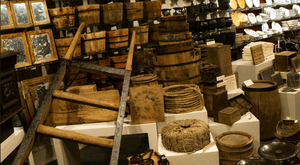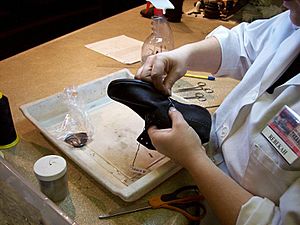Arabia Steamboat Museum facts for kids
| Established | November 13, 1991 |
|---|---|
| Location | River Market, Kansas City, Missouri, United States |
| Type | History museum |
| Collections | Cargo of steamboat that sank in 1856 |
| Collection size | 200 tons |
The Arabia Steamboat Museum in Kansas City, Missouri, is a special place. It shows off amazing items found from the Arabia, a steamboat that sank in the Missouri River way back in 1856. This museum opened its doors on November 13, 1991. It's run by the people who found and dug up the Arabia. They say it has the biggest collection of items from before the American Civil War anywhere!
Contents
Exploring the Museum
When you visit the museum, you first watch short videos. These videos tell the story of how the Arabia sank and how its treasures were found. There's also a longer film you can watch called The Fall and Rise of the Steamboat Arabia.
What You Can See
After the films, you get to see all the cool items found from the steamboat. You can also watch staff members working in a special lab. They carefully clean and fix the old items. This work takes a long time. Even a small nail can take over an hour to clean! Shoes and boots might take up to three months to get ready for display.
You can also walk on a full-size model of the Arabia's main deck. It's 171 feet long! Here, you can see videos of the digging process. You'll also find the ship's original boilers, engine, anchor, and even the skeleton of a mule. The museum also shows off the ship's huge 6-ton stern (the back part) and a rebuilt paddle wheel.
Amazing Collections
The museum has hundreds of thousands of items. These were all things people would have used every day on the American frontier in 1856. Imagine finding over 4,000 boots and shoes, 247 hats, and 235 ax heads! There are even 29 jars of pickles and a children's doll. Most of these items were brand new and were being shipped to stores on the frontier. One newspaper called the collection "an Aladdin's cave of objects from the year 1856."
Special Exhibits
The museum often adds new things to see. On November 22, 2013, a new exhibit opened. It featured the engine from the Missouri Packet. This was the very first steamboat to sink in the Missouri River, back in 1820. The Hawley family, who found the Arabia, dug up this engine in 1987. It didn't have many other items with it, but it inspired them to keep looking for sunken steamboats. This engine is believed to be the oldest working steam engine from a ship in the United States.
In January 2013, the museum closed for a short time. This was to fix the ceiling and make the displays even better.
Traveling Treasures
Sometimes, items from the museum travel to other places. In 2014, about 2,000 items from the Arabia went to the Heinz History Center in Pittsburgh, Pennsylvania. The Arabia was built near Pittsburgh in 1853, so the exhibit was called "Pittsburgh's Lost Steamboat: Treasures of the Arabia." Visitors there learned about how the items were saved and even saw a copy of the mule that was on the ship. This special exhibit was open until January 4, 2015.
The Steamboat's Story
The Arabia was a steamboat that hit a hidden tree snag in the Missouri River on September 5, 1856. All 130 people on board were safe, but about 220 tons of cargo sank with the ship. Soon after, the river changed its path, and the Arabia became buried underground.
Finding the Ship
The cargo was meant for 16 towns on the American frontier. It stayed buried under a cornfield in Wyandotte County, Kansas, for 132 years! Then, in 1988, a group called River Salvage Inc. found it. These "treasure hunters" started digging. The group included David, Greg, and Bob Hawley, who owned a refrigeration repair business. They teamed up with Jerry Mackey and David Lutrell, along with family and friends.
They dug from November 1988 to February 1989. At first, they wanted to sell what they found. But they quickly realized how important these historical items were. So, they decided to open a museum instead. Today, the Hawley family still owns and runs the museum. You can often find them there, greeting visitors and answering questions.
Saving the Treasures
After digging up the Arabia, the next big challenge was learning how to clean and save the items. During the dig, things made of wood or leather were kept safe in blocks of ice. Large wooden pieces, like the stern and paddle wheel, were put into a special pool.
The team worked with experts from other museums to learn how to preserve things found in freshwater. Items like wood and leather are soaked in a special food preservative called polyethylene glycol (PEG). Then, they are frozen and dried. Metal items are gently cleaned with tools and special erasers. Food and drinks in bottles are filled with a gas called nitrogen to keep them fresh. Shoes, boots, and clothes often need to be sewn back together because their old threads dissolved in the water.
The work of saving these items is still happening at the museum today. It was once thought it would be finished by 2022, but it will likely take another 10-12 years.
Museum's Journey
The Arabia Steamboat Museum first opened on November 13, 1991. The museum was led by the two brothers who found the Arabia, Greg and David Hawley, along with their parents, Bob and Florence Hawley. Sadly, Greg passed away in 2009, Bob in 2019, and Florence in 2021. David Hawley continues to run the museum.
The museum's current location in Kansas City is about 7 miles from where the Arabia sank. Its lease there ends in 2026.
Future Plans
There are plans to move and make the Arabia Steamboat Museum even bigger. In 2019, there was an idea to build a larger museum in Jefferson City, about 140 miles from the wreck site.
In 2021, new plans were made to create the National Steamboat Museum at Marshall Junction, Missouri. This spot is about 77 miles from where the Arabia sank. These plans include digging up five more steamboats! This way, six different steamboats could be shown and explained at the new museum.
See also




